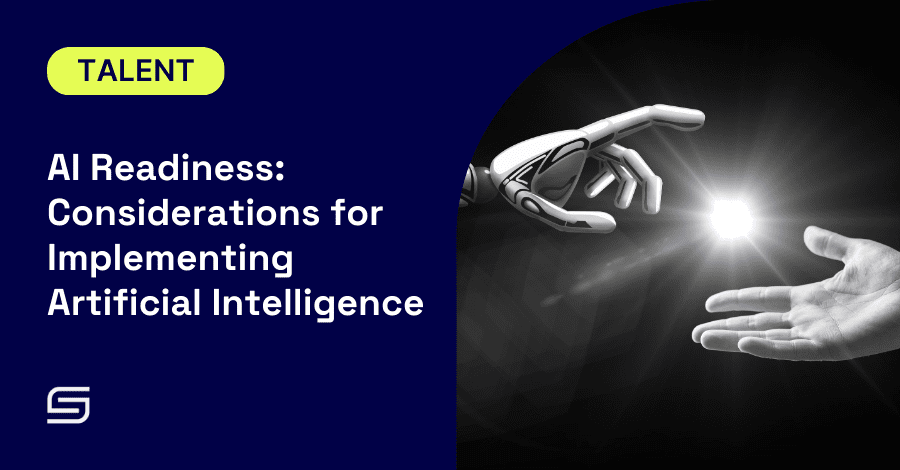AI Readiness: Considerations for Implementing Artificial Intelligence

Artificial Intelligence (AI) is on the cusp of transforming business operations… or is it? AI in and of itself is not new (or even always exciting) in the corporate world – two simple examples being the use of a spam filter or automated email response, for example. However, what is novel about generative AI is the amount of power it can wield.
There seems to be two camps of people: those who are excited to embrace its potential, and those who question whether it’s worth the hype (and risks). Either way, not many have gotten very far down the path, indicating that when it comes to readiness, execution, and adoption of AI at scale – the learning curve is proving to be very steep.
As a Hire-Train-Deploy (HTD) provider, we have conversations every week with clients and prospects, both Fortune 500 companies and government agencies, about their specific talent gaps. As they consider how and where to adopt AI, they turn to us for guidance based on what we’re seeing in the market.
Below we’re examining AI from five different-but-equally-critical lenses. However, before you think that this is another simplified how-to guide for implementing AI, we have one small but important disclaimer – avoid a one-size-fits-all (or even -most!) mentality.
To be successful, businesses must implement each AI tool accordingly. There’s no blanket approach to adopting AI technology that works across every best-in-class solution provider. How a company adopts Pega or Databricks (and by extension hire Pega developers or Databricks developers) is very different from the considerations for a tool like ServiceNow or Salesforce (and again, by extension hiring ServiceNow certified developers or Salesforce specialists).
We recommend you use the below as a guide for what should be considered when adopting AI technology in the year ahead.
Governance
There are varying comfort levels when it comes to AI across key business stakeholders. Executives, employees, customers, partners, and investors all have their own opinions about how it should be implemented.
Internal buy-in is critical for AI-leery employees. To clear a path forward for adoption, organizations should define and articulate their AI mission and goals as well as a code of ethics. Doing so will ensure that AI is implemented in a way that’s in line with corporate values and to achieve specific outcomes.
Most companies have not yet taken this first step. According to an ISACA study, only 10% of organizations have formal policies in place for generative AI.
Resources and Oversight
According to a 2023 FedScoop/Microsoft report, 71% of government agency leaders have established teams devoted to developing AI policies and resources. This makes sense, given the specific constraints on agencies in our highly regulated public sector.
For any organization, it’s important to ensure those with program oversight are properly supported. The size of the organization, the industry, and the planned speed of implementation are just a few of the considerations to keep in mind when it comes to building the right team.
Data
In our tech-powered world, a company is only as good as its data. And unfortunately, most organizations have disparate data across many systems. Before any serious AI progress can be made, all data must be available, accurate, consistent, and secure.
Companies will need to establish a data governance program. Developing a data strategy, creating policies and processes, and overseeing this program requires an executive owner who can work in lock step with the AI team – and often with specific technology vendors to ensure all requirements are met.
Implementation Strategy
All the above lays the groundwork for the implementation of AI tools, but it can’t all be done at once. Stakeholders will need to establish a uniform approach to examining business processes and workflows and determining their readiness for AI.
There will be several criteria by which to judge them, including factors like business impact, risk, implementation time, and budget/resource needs. The weight each business puts on these factors will be unique to their operations and AI goals.
Change management
Last, and very certainly not least, is the need for change management. It’s a massive consideration when it comes to implementing AI. Preparing the company for a faster pace of change is critical to ensuring all stakeholders are on board.
The narrative around AI hasn’t always been a positive one in the eyes of employees. We’ve all seen the “AI is coming for your jobs” headlines, touting its ability to replace workers. What executives must get right is communicating the value of AI (again, going back to defining an overarching AI mission and goals) and how it will enhance employee work. If this isn’t clear in any way, companies could face business disruption, culture challenges, employee attrition, and even a decline in customer satisfaction.
Today’s sophisticated AI tools hold a lot of promise – but not all companies are ready for all that it brings. While getting left behind while others adopt AI is a real fear, it’s even more detrimental to go at it unprepared. These five areas of consideration can be a great starting point for your AI journey.
Let’s Build Your Team
Connect with the Smoothstack team to learn how to close your digital skills gap with a custom-trained team.